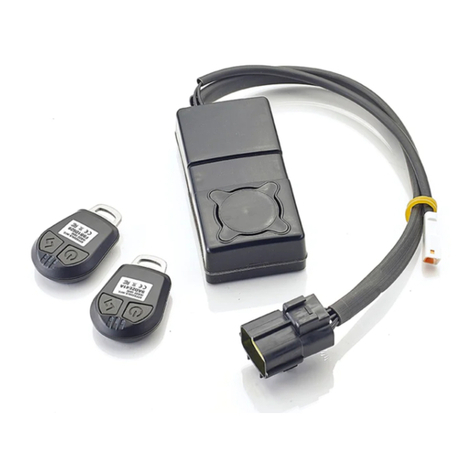
EN
Note:
• Power supply voltage range -
12 volt DC negative earth.
• System current consumption
<2.5 mA in armed condition.
• Record the serial number and tag
number from the underside of the
alarm unit on to the alarm
installation certificate.
• Once the Alarm/Immobiliser has
been fitted, it will become an
integral part of the motorcycle and
cannot be removed.
• A suitable heat gun and hand-held
power drill fitted with a 2 mm
diameter drill bit are required to fit
this kit.
Reed-switch Fitment
1. Remove the seat and disconnect the
battery, negative (black) lead first.
2. Undo the battery strap and remove the
battery.
3. Place the seat on a clean non-abrasive
surface and note the position of the two
fixing holes shown.
Warning
This accessory kit is designed for use on
Triumph Daytona 675 motorcycles only and
should not be fitted to any other Triumph
model or to any other manufacturer’s
motorcycle. Fitting this accessory kit to any
other Triumph model, or to any other
manufacturer’s motorcycle will affect the
performance, stability and handling of the
motorcycle. This may affect the rider’s ability
to control the motorcycle and could cause an
accident.
Warning
Always have Triumph approved parts,
accessories and conversions fitted by a
trained technician of an authorised Triumph
dealer. The fitment of parts, accessories and
conversions by a technician who is not of an
authorised Triumph dealer may affect the
handling, stability or other aspects of the
motorcycle’s operation which may result in
loss of motorcycle control and an accident.
Warning
Throughout this operation, ensure that the
motorcycle is stabilised and adequately
supported on a paddock stand to prevent
risk of injury from the motorcycle falling.
Warning
Always ensure that newly installed wiring
does not chafe against other parts of the
motorcycle such that they may be rubbed
through and cause an electrical problem. In
addition, always ensure that newly installed
wiring will not restrict steering movement.
Both conditions are hazardous and could
give rise to a dangerous riding condition
resulting in a fire, loss of motorcycle control
and/or an accident.
Publication part number A9900449, Issue 2, ADC 9148
© Triumph Designs Ltd 2009.


























